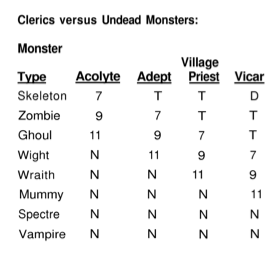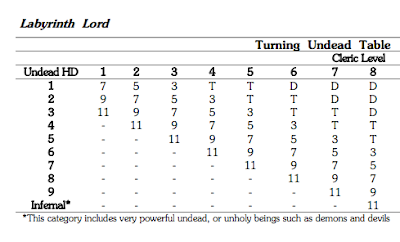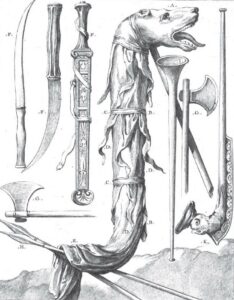 |
| Image from Wikipedia |
Here is the first of the Hexagram paths, for the warrior traits.
Traits all range from 0 to 6 and describe some core capability (broadly understood) of an adventurer. The design is built around the idea of niche protection, popularized recently by Lamentations of the Flame Princess. For example, characters do not get better at melee combat in any way other than taking ranks in the melee combat trait. That being said, unlike Lamentations, the ability to take off-path traits (with diegetic assistance) allows any character to get better at anything, though at a greater cost, and only up to a certain limit (that limit being 5 by default). Thus, a sorcerer can get better at using a sword, but at the cost of an entire level’s worth of learned trait progression (as the choice is between 2 path trait improvements or 1 off-path improvement).
The limit of 6 on any trait combats the tendency toward numerical inflation and keeps the range of any specific trait reasonable (preventing problems like falling off the RNG). E6 was one attempt to solve that problem that works okay in the context of 3E, but feats and multiclassing are not acceptable solutions to me (I believe the path, prototype, and trait system models the same thing with superior approachability and flexibility). Thus, hexagram emphasizes broad development at higher levels over deep development. A 20th level 3E fighter gets +20 to hit. A 20th level Hexagram path of steel character will have a collection of traits accumulated over their career.
You will note that the style of the traits is not a list of powers that can be used, one per level of skill, but rather a particular kind of benefit or talent that increases with the number of points in the trait. This is maintained, by the way, in the sorcery traits too. I think you will find that cool things to have or do are present in all the paths.
I’m still not sure exactly what the best term to use for trait units is. Points have an association with point buy systems that is connected to a “character build” style of play that I don’t want to emphasize. “Ranks” is another potential term (as in: 4 ranks of spells, 3 ranks of melee combat). In any case, in the final draft I’ll normalize the language to only use one term, once I decide what is best.
Many of these trait names are still insufferably bland and will certainly be improved. For example, certainly there is a better trait name than bonus HP. (Yes, toughness would work, but I don’t want to use the same name as a common SRD feat.) The exact number and ordering of the traits is also not final (the order is important as the table may be rolled upon with arbitrary dice, and the more iconic and common traits should be toward the bottom).
I think it should be easy to create either a generic traditional fantasy game fighter by concentrating improvement on the first few traits (this is encouraged with the prototype system and ease of advancement in starting traits). Further, using the guided randomness of rolling d6 (for example) on the trait table upon levelling will result in an interesting and viable character. And a large diversity of character concepts should be possible using this list of traits, all while staying within the domain of the traditional fantasy game (no need to resort to “melee spells” or something similar, as was done with 4E powers).
I am particularly happy with the implementation of tactical superiority (forced movement and mobility without the need to use a grid) and warband (a small group of fiercely loyal followers that derive their combat skills from their leader and also create obvious hooks into domain level play). And, if you just want a fighter that gets really good at hitting things, the first six traits on the path table provide 18 levels worth of advancement.
T is the number of ranks in the trait. So, melee combat 3 means T = 3 which means +3 to attacks with melee weapons (in this case). I think this is clear in context, but let me know if it isn’t.
The Path of Steel
- Melee combat. +T to attack rolls with melee weapons.
- Missile combat. +T to attack rolls with missile weapons.
- Damage. +T to weapon damage rolls.
- Bonus HP. +T HP on top of normal hit dice and constitution bonus.
- Defense. +T floating AC bonus (may apply to companions).
- Cleave. T extra attacks usable after taking an enemy down.
- Unarmed Combat. +T Attack, max damage T, and T cleaves while unarmed.
- Tactical superiority. T x 5′ worth of reaction/forced movement.
- Warband. Attract T loyal followers.
- Frenzy. Use berserk rage in combat.
- Animal companion. T HD worth of animal companions.
 |
| Image from Wikipedia |
Melee combat provides +T to attacks with melee weapons. Melee combat is also used for improvised thrown weapons. Weapons designed for throwing (such as throwing knives or shuriken) may use the most advantageous of melee combat or missile combat.
Missile combat provides +T to attacks with missile weapons such as bows, crossbows, and slings.
Damage provides +T damage on any attack with melee or missile weapons (but not unarmed combat; see the unarmed combat trait below for details).
Bonus HP. +T HP on top of the normal hit dice total.
Defense. Experienced combatants learn tricks to more easily dodge blows and turn deadly blows into minor wounds, even when unarmored. +T AC. This bonus does not stack with armor, and using this bonus requires active engagement with combat (it is not, for example, useable when picking a lock or casting a spell). This trait allows warriors to fight effectively when lightly armored. Defense is a floating bonus that may be applied to companions as well. Assistance to companions must be declared on the warriors turn, and must make diegetic sense (for example, a warrior must be adjacent to a companion, or able to move into an interposition).
Cleave. +1 free weapon attack per round. A free attack may only be used after taking down an enemy.
 |
| Image from Wikipedia |
Unarmed Combat. Training to fight without weapons. Allows more than 1 HP damage to be inflicted with unarmed strikes (max = T, re-roll any damage results higher than T), and damage may be lethal. In addition, functions as melee combat and cleave for unarmed attacks (i.e., grants attack bonus and cleave attacks when unarmed). Allows one free parry per turn while unarmed. If T = 6, parries of missile weapons may be attempted. See combat section for details about untrained unarmed combat and parrying.
Tactical superiority. Experienced combattants know how to move about the field of combat while keeping their defences up, and also how to force enemies into the position of their choosing. T x 5′ of extra movement per round, which may be applied to either the character or enemies the character is fighting (following a successful attack roll, which may also do damage as normal). Forcing a large opponent 5′ costs 10′ worth of forced movement (or more for even larger creatures). All uses of tactical superiority must make sense within the particular situation (no shifting through force fields or levitating across pits, for example, unless the character has some other method of accomplishing those tasks). This extra movement may be used in reaction to an enemy’s action, for example to become the target of an attack meant for a companion, but may only be used once per round (remember that everything during a round is really happening at the same time, so this should not be considered dissociated).
 |
| Image from Wikipedia |
Warband. Warriors of repute often attract followers who wish to partake in the glory of adventure. Up to T warband members will gather to your standard. Warband members do not consume XP as normal retainers and derive the following traits from their leader (-2, minimum 0): melee attack, missile attack, defense (only personal), damage, HD, HP, unarmed. Thus, a master archer’s warband will also have skill with the bow. Slain warband members will be replaced gradually, at the rate the referee deems reasonable (for example, it may be several months following a great defeat before new warband members arrive). For very experienced fighters, warband members often become trusted lieutenants. Warband members are fanatically loyal, though they will not needlessly endanger themselves (by, for example, sampling random potions or walking forward to trigger a likely trap). They never desert due to fear or betray the warrior they follow for money. If mistreated (referee discretion), they may leave, but in time a warrior will be able to recruit replacements. Further, each warband member can lead up to T x 100 trained soldiers and hold a cleared 6 mile hex worth of territory. Warband members do not expect treasure (fighting alongside a great warrior is enough) though they will be more valuable allies if well-equipped.
Frenzy. Rage is a gift in combat to some. This may be mundane berserkergang or the channeling of dark spirits. Initiating a frenzy might require rituals, stimulants, or other forms of preparation (referee discretion). Characters will only use melee weapons or unarmed combat while in a frenzy. Minimum damage T with any successful attack. +T attack (does not stack with melee combat bonus). Intelligent enemies with fewer HD must immediately make a morale check when confronted with a frenzying warrior. Will not retreat or flee while frenzying. At the end of a frenzy, the warrior takes 1d6 damage and must succeed in a saving throw versus paralyzation or fall unconscious. All actions for the next 6 turns (one hour) take a penalty equal to the post-frenzy damage.
Animal companion. The character has an extremely well trained animal or mount. In some cases, there may even be some sort of subtle mind-link. One creature of T HD, with special abilities being worth 1 HD (such as poison or flight). Animal companions are not subject to normal morale rules (unlike standard mounts or dungeon dogs), but can only be given simple and direct commands, which they will seek to accomplish to the best of their ability (players may direct movement and attacks in most cases, but exact actions are always subject to the referee, as the animal companion is still strictly speaking an NPC). Animals slain may be replaced (diegetically). Animals are given the same saving throw versus death at 0 HP as are PCs (see combat section).









